Waste Statistics 2005
5 Individual waste sources and status in relation to targets for 2008
- 5.1 Waste from households
- 5.2 Waste from the service sector
- 5.3 Waste from industry
- 5.4 Waste from building and construction activities
- 5.5 Residues from coal-fired power plants
- 5.6 Sludge from municipal wastewater treatment plants
- 5.7 Residues from waste incineration plants
5.1 Waste from households
Waste from households covers the waste types domestic waste, bulky waste, and garden waste, which in turn are divided into individual fractions, e.g. paper and cardboard, bottles and glass, and food waste/other organic waste. Table 20 shows waste arisings by mixed and separately collected fractions to the extent it has been possible to register these individually.
This means, for example, that the amount of paper and cardboard stated does not show the complete potential in household waste arisings but only the amount which has been separated and collected for recycling. The rest of the paper is part of the fraction various combustible.
Waste arisings from households in 2005 amounted to around 3,338,000 tonnes, which constitutes a 6 per cent increase from 2004. The increase in the total amount of household waste can be tracked for the major part to the fractions various non-combustible and ferrous metal separated for recycling. These two fractions went up by 23 per cent and 21 per cent respectively.
The fraction various combustible, however, still makes up the largest part of total household waste arisings, namely around 61 per cent.

Source: ISAG reports. (1) For the year 1996, waste from the fraction ferrous metal is included under "Other waste".
Table 20 shows shifts between the different household waste fractions, so that various combustible, various non-combustible, paper and cardboard separated for recycling, bottles and glass separated for recycling, branches, leaves, grass etc. and ferrous metal separated for recycling have increased by 4 per cent, 23 per cent, 13 per cent, 13 per cent, 13 per cent and 21 per cent respectively, compared to 2004. Food waste/other organic waste separated for recycling, hazardous waste and other waste, on the other hand, went down by 15 per cent, 11 per cent and 26 per cent respectively relative to 2004.
5.1.1 Household waste per capita and per household
In Table 21, household waste arisings are stated per capita and per household. Furthermore, the Table shows total arisings analysed between selected waste types and separately collected waste fractions.
Total household waste generation per capita amounted to 617 kg in 2005, which is 31 kg more than in 2004. Household waste per household was 1336 kg in 2005.
Of these, domestic waste per capita and per household was 316 kg and 685 kg respectively in 2005. Compared to 2004, this means a slight increase of 3 kg per capita, while the amount per household grew similarly by 3 kg.
The table shows that bulky waste is the main contributor to the increase in waste arisings in the period. Bulky waste thus increased from 126 kg per capita in 2004 to 146 kg per capita in 2005. The reason for the increase must be ascribed to the fact that people have more disposable income and therefore the number refurbishments and procurement of new furniture have gone up.

Source: ISAG reports. Statistics Denmark's statement of population growth and number of households has been used. Note that Tables 20 and 21 are not readily comparable, as Table 20 concerns waste generation stated by fraction while Table 21 also includes waste types.
5.1.2 Domestic waste
Domestic waste from households covers ordinary waste from private household consumption. This includes paper, bottles, glass, organic food waste and other waste. Usually, domestic waste is collected from households at regular intervals, once a week or once every other week.
As mentioned in Chapter 1, domestic waste amounted to 1,711,000 tonnes in 2005, which is 19,000 tonnes more than in 2004. Since 1994, the amount of domestic waste has varied slightly from year to year, however, without showing any clear trend. The amount has increased by 3 per cent over the entire period, cf. Table 3.
In 2005, 18 per cent of domestic waste was recycled, whereas 81 per cent was incinerated and about 1 per cent landfilled. The breakdown by treatment option therefore shows slight changes from 2004 when 17 per cent was recycled, 83 per cent was incinerated and around 1 per cent landfilled.
For the early years, packaging waste is included as part of the waste type domestic waste. To make comparison with these early years possible, packaging waste from households in 2001, 2002, 2003, 2004 and 2005 of 107,000, 117,000, 85,000, 84,000 and 96,000 tonnes respectively has been included in Figure 7.
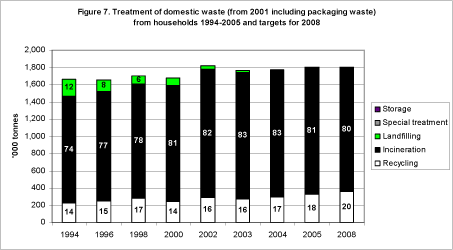
Source: same as Tables 1 and 2. Note that arisings in 2008 have been set to correspond to arisings in 2005. The figures are not projections of developments in waste arisings.
Figure 7 shows that the relative distribution in the period 1994 to 2005 among treatment options has varied only little. From 1994 over the entire period the trend has been that 80 per cent of domestic waste is incinerated. Recycling is 16 per cent and landfilling 5 per cent. At the same time, the figures show that the amount of waste led to landfills has gone down.
Even though the targets in Waste Strategy 2005-2008 are close to being met, too much domestic waste is still being incinerated and landfilled relative to the targets, and too little recycled.
One of the measures which can help ensure greater recycling of domestic waste is the requirement that, from August 2006, Danish municipalities are obliged to separate plastic and metal packaging waste from households for recycling. Waste, which so far has been led to incineration.
It should be noted that domestic waste is considered suitable for incineration and it is therefore not to be landfilled. If not recycled, domestic waste is to be incinerated. However, islands that are not connected by land to an incineration plant are exempt from this obligation.

Source: same as Tables 1 and 2. Note that arisings in 2008 have been set to correspond to arisings in 2005. The figures are not projections of developments in waste arisings.
5.1.3 Bulky waste
Bulky waste generated by Danish households amounted to 791,000 tonnes in 2005. This is 104,000 tonnes more than in 2004. In other words, there has been an increase of 15 per cent.
During the period from 1994 to 2005 bulky waste increased by 31 per cent. The increase in bulky waste amounts is due to a real increase but also very much to the implementation of pick-up and bring schemes for this waste type.
Figure 8 shows bulky waste analysed between three treatment options: landfilling, incineration, and recycling for the period 1994 to 2005. The general trend for the period is that a larger proportion of bulky waste is being incinerated, whereas decreasing amounts are being landfilled. For recycling the percentage rate is stable but showing a slight downward trend in 2005. Furthermore, there is an upward trend in the amount being stored.
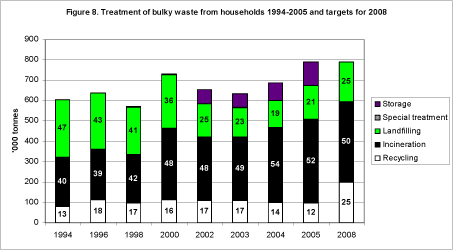
Source: same as Tables 1 and 2. Note that arisings in 2008 have been set to correspond to arisings in 2005. The figures are not projections of developments in waste arisings.
In 2005, 52 per cent of bulky waste was incinerated, the rate for landfilling was 21 per cent, and the rate for recycling 12 per cent. The remaining 15 per cent, however, was led to temporary storage; i.e. temporary landfilling of waste suitable for incineration. This means that the waste is stored until it can be incinerated for the purpose of energy/heat generation[14]. Therefore, the real incineration rate for bulky waste is higher than 52 per cent. At the same time, the figures show that the amount of waste led to landfills has gone down considerably since 1994.
The target of a maximum landfilling rate of 25 per cent has thus been met. However, too much bulky waste is still being incinerated and not enough is being recycled.
If targets for recycling in 2008 are to be met, considerable efforts are required to separate and collect more of the different waste fractions in bulky waste. A number of initiatives covering e.g. cardboard, waste electrical and electronic equipment have been, or are in the process of being, implemented.

Source: same as Tables 1 and 2. Note that arisings in 2008 have been set to correspond to arisings in 2005. The figures are not projections of developments in waste arisings.
Storage means that the waste in question has been assigned to temporary storage by local authorities (the local council), cf. section 37(3) of the Statutory Order on Waste. Denmark has excess incineration capacity, but storage can be due to e.g. repairs or shut down of operations at plants.
5.1.4 Garden waste
The amount of garden waste collected from households in 2005 came to 563,000 tonnes. This is an increase of 63.000 tonnes from 2004.
Throughout the 1990s the amount of garden waste increased steadily. From 1994 to 2005 there has thus been a 96 per cent increase.
This increase does not reflect a real increase in garden waste. It is rather the result of increasing opportunities for householders to dispose of garden waste at municipal waste treatment plants at the expense of home-composting. This means larger waste volumes to be treated in the municipal waste treatment system.
Treatment of garden waste is presented in Figure 9. In 2005, 99 per cent of garden waste was recycled, and around 1 per cent was landfilled.
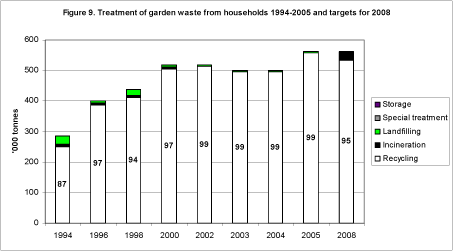
Source: same as Tables 1 and 2. Note that arisings in 2008 have been set to correspond to arisings in 2005. The figures are not projections of developments in waste arisings.

Source: same as Tables 1 and 2. Note that arisings in 2008 have been set to correspond to arisings in 2005. The figures are not projections of developments in waste arisings.
So, the targets for recycling and incineration of garden waste from households have been met by a good margin. Estimates indicate that it is impossible to increase the recycling rate any further.
5.2 Waste from the service sector
Waste from the service sector[15] amounted to 1,841,000 tonnes in 2005. This is up by 8,000 tonnes, or about the same as in 2004. As mentioned in Chapter 1, there has been a dramatic increase in waste arisings from the service sector since 2001 and the increase should therefore be regarded with some caution. However, the waste arisings appear to have stabilised over recent years.
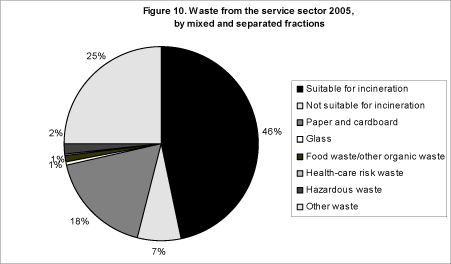
Source: ISAG reports 2005. The key is listed clockwise beginning at "12 o'clock".
Waste from the service sector is analysed by mixed and separated fractions in Figure 10. There is no great change in the percentage distribution of fractions from 2004 to 2005. Changes are between 0 and 1 per cent. Where waste suitable for incineration has dropped by 1 per cent, paper and cardboard has gone up by 1 per cent. For the remaining waste there have not been any changes. Waste suitable for incineration, paper and cardboard, and other waste are the three largest waste fractions from the service sector with 46 per cent, 18 per cent, and 25 per cent respectively.

Source: same as Tables 1 and 2. Note that arisings in 2008 have been set to correspond to arisings in 2005. The figures are not projections of developments in waste arisings.
Storage means that the waste in question has been assigned to temporary storage by local authorities (the local council), cf. section 37(3) of the Statutory Order on Waste. Denmark has excess incineration capacity, but storage can be due to e.g. repairs or shut down of operations at installations.
Table 26 shows the development in waste generation from the service sector in the period 2004 to 2005, analysed by fractions. It is apparent that most of the increase in the amount of waste from the service sector is to be found in the fractions various non-combustible and paper and cardboard. On the other hand, the fraction bottles and glass has gone down by as much as 29 per cent.

Source: ISAG 2004 and 2005.
Of the 1,841,000 tonnes of waste which the service sector generated in 2005, 45 per cent was recycled, another 45 per cent was incinerated, while 8 per cent was landfilled and 1 per cent placed in temporary storage, cf. Figure 11. The amount of waste that was recycled has thus gone up some, while the amount that is led to incineration has gone down compared to 2004. The waste put in temporary storage will be incinerated when incineration capacity becomes available[16]. In other words, the incineration rate is actually higher than the 45 per cent. Figure 11 shows that a still greater proportion of waste from the service sector is being recycled. This means there has been a diversion of waste volumes from incineration to recycling.
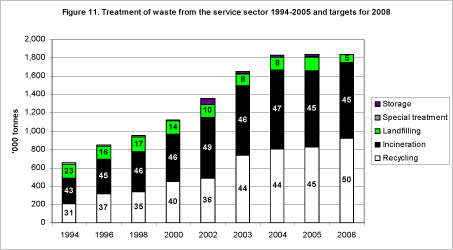
Source: same as Tables 1 and 2. Note that arisings in 2008 have been set to correspond to arisings in 2005. The figures are not projections of developments in waste arisings.
As stressed in Chapter 1, the increase in waste arisings from the service sector from 2001 should be regarded with some caution.
In relation to the targets for treatment in 2008 set out in Waste Strategy 2005-2008, too little waste from the service sector was still recycled and too much landfilled in 2005. If the 2008 targets are to be met, separation and collection of waste must be improved so that a larger proportion of recyclable materials can be recycled, and so that environmentally harmful waste types can be separated and treated separately.
5.3 Waste from industry
Waste generation from industry amounted to 1,855,000 tonnes in 2005, which is the same as in 2004. As mentioned in Chapter 1, since 2001 there has been a drop in the amount of waste from industry. However, the amount seems to have stabilised over recent years.
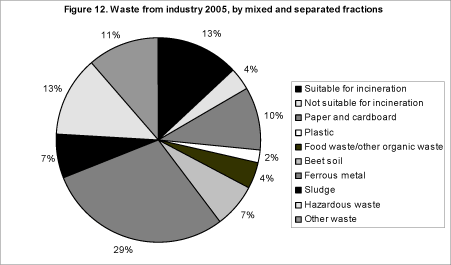
Source: ISAG reports 2005. The key is listed clockwise beginning at "12 o'clock".
Figure 12 shows a breakdown of waste from industry by mixed and separated fractions. As can be seen, ferrous metal is by far the largest single fraction, followed by the mixed fraction waste suitable for incineration, hazardous waste and other waste.
The individual fractions' percentage shares of total industrial waste are more or less unchanged from 2004. The greatest change is in ferrous metal which increased from 25 per cent in 2004 to 29 per cent in 2005, whereas the amount of beet soil and waste not suitable for incineration went down by 3 per cent. The remaining fractions show changes within 0-2 percentage points.
Table 27 shows the development in waste generation by industry in the period 2004 to 2005, analysed by fractions. As can be seen, the amount of paper and cardboard has gone up 27 per cent, while ferrous metal has gone up 18 per cent. Various non-combustible, on the other hand, has gone down 45 per cent and beet soil 34 per cent.
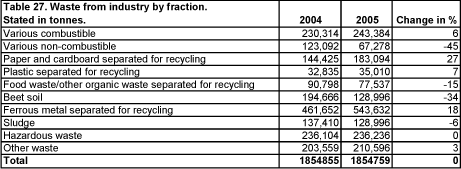
Source: ISAG 2004 and 2005.
Treatment of waste from industry is shown in Figure 13. In 2005, 65 per cent of the waste from this sector was recycled.
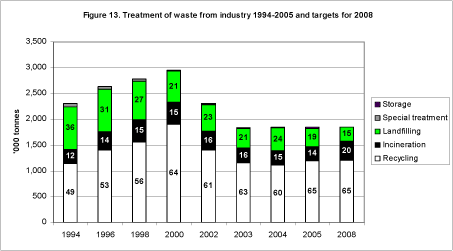
Source: same as Tables 1 and 2. Note that arisings in 2008 have been set to correspond to arisings in 2005. The figures are not projections of developments in waste arisings.
As stressed in Chapter 1, the fall in waste arisings from industry from 2001 should be regarded with some caution.

Source: same as Tables 1 and 2. Note that arisings in 2008 have been set to correspond to arisings in 2005. The figures are not projections of developments in waste arisings.
Storage means that the waste in question has been assigned to temporary storage by local authorities (the local council), cf. section 37(3) of the Statutory Order on Waste. Denmark has excess incineration capacity, but storage can be due to e.g. repairs or shut down of operations at installations.
The proportion of industrial waste led to incineration in 2005 was 14 per cent. The landfilling rate dropped by 5 per cent from 2004 to 2005, ending at 19 per cent in 2005.
This means that the 2008 target of landfilling a maximum of 15 per cent of industrial waste has not been met. Denmark still landfills far too much industrial waste. Even if the rate of landfilling has taken a positive direction since 1994, there is still some way to go before the 2008 target for this treatment option is met, cf. Figure 13.
The volumes and composition of waste from industry vary according to the sector generating the waste, as well as size and number of enterprises. Possibilities of waste prevention or recycling will therefore differ from one waste fraction and sector to another.
In order to meet the targets in the Waste Strategy 2005-2008, the Danish EPA has selected a number of waste types from industry to come into focus. These waste types include waste from foundries and shredder waste, which are to be diverted from landfilling to recycling whenever environmentally and economically efficient.
With the latest amendment to the Statutory Order on Waste the Danish EPA has implemented a number of changes to the ISAG system, so that since 2001 it has been possible to analyse waste from industry between eleven different sectors.
Waste generation in industry stated by sector and treatment option can be seen in Table 29.
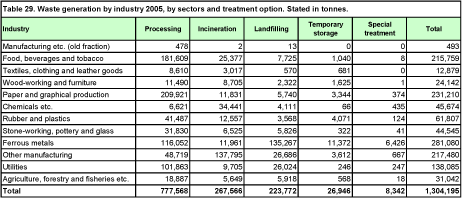
Source: ISAG reports 2005. The Table does not cover beet soil and ferrous metal reported by large scrap dealers.
As apparent from the table, food, beverages, and tobacco; the ferrous metal industry; other manufacturing; the paper and graphical production industry; and utilities contributed around 70 per cent of waste from industry in 2005. The amount of waste from manufacturing etc. was 493 tonnes. In 2002, waste generation from this source amounted to 238,815 tonnes, which means that reporting enterprises have improved their reporting on the new commercial sources (cf. as the commercial source manufacturing industries etc. was discontinued in 2001).
5.4 Waste from building and construction activities
The generation of waste by the building and construction sector increased from 2004 to 2005. Volumes of construction and demolition waste amounted to 5,270,000 tonnes in 2005, which is 775,000 tonnes, or 17 per cent, more than in 2004. This increase can be attributed e.g. to greater activity in the building and construction sector in general.
As is apparent from Table 30, which shows the development in waste arisings in the building and construction sector, the greatest increase in total arisings stems from the fraction soil and stone, which increased by 565,000 tonnes or 41 per cent. Also in the fraction various non-combustible and other waste, the increase is substantial, at 22 and 21 per cent respectively. There is an 11-per-cent drop in arisings of other construction/demolition waste. By far the major part, or 94 per cent, of waste generated by the building and construction sector is recycled.

Source: ISAG 2004 and 2005.
Figure 14 shows that the rate of waste which is recycled in 2005 remained the same as 2004. This also applies to incineration and landfilling.
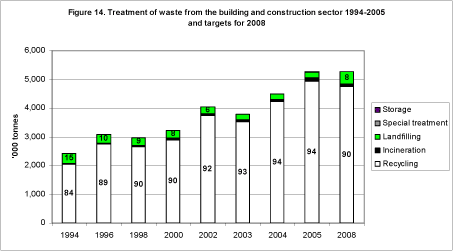
Source: same as Tables 1 and 2. Note that arisings in 2008 have been set to correspond to arisings in 2005. The figures are not projections of developments in waste arisings.
As the figure also shows the recycling rate for construction and demolition waste increased by 10 per cent in the period 1994 to 2005. At the same time the landfilling rate went down by 11 per cent. The figure also shows that the distribution of waste between the different treatment options has been in line with targets for 2008 since 2000.

Source: same as Tables 1 and 2. Note that arisings in 2008 have been set to correspond to arisings in 2005. The figures are not projections of developments in waste arisings.
Storage means that the waste in question has been assigned to temporary storage by local authorities (the local council), cf. section 37(3) of the Statutory Order on Waste. Denmark has excess incineration capacity, but storage can be due to e.g. repairs or shut down of operations at installations.
The high recycling rate for construction and demolition waste is due partly to the fact that recycled waste, unlike landfilled or incinerated waste, is exempt from taxation, and partly due to a 1995 departmental circular on municipal regulation concerning the separation of construction and demolition waste intended for recycling[17]. In addition, the Ministry of the Environment and the Danish Contractors' Association have entered an agreement on selective demolition of buildings.
Figure 15 shows construction and demolition waste analysed by mixed and separated fractions for 2005. It can be seen that the bulk of building waste consists of concrete, asphalt, and soil and stone.
Relative to 2004, the share of soil and stone has gone up, from 31 per cent in 2003 to 37 per cent in 2005. This is due to greater activity in the building and construction sector, resulting in more soil being sent to some of the treatment plants. Otherwise, there have not been great changes in the spread between fractions from 2004 to 2005. Changes are between 0 and 3 percentage points.
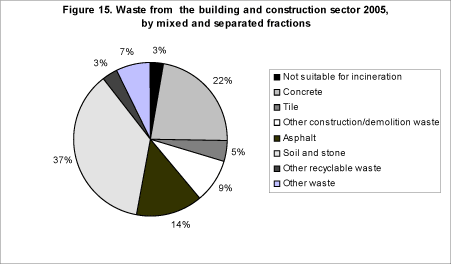
Source: ISAG reports 2005. The key is listed clockwise beginning at "12 o'clock".
A large part of the waste from the building and construction sector is reprocessed at mobile crushing plants which are used for different assignments at different locations throughout Denmark.
The owner of the mobile crushing plant is responsible for the ISAG reports to the Danish EPA, but sometimes the entrepreneur also reports the waste. The Danish EPA is very much aware of this possible source of double reporting, and great efforts are being made, in co-operation with the providers of the reports, to ensure quality control and avoid double reporting.
5.5 Residues from coal-fired power plants
The generation of residues at coal-fired power plants varies from one year to the next due to variations in Danish imports/exports of electricity to and from Sweden and Norway. Imports/exports of electricity to and from Sweden and Norway depend largely on precipitation in these countries - if there is much precipitation, much electricity is generated from hydropower in Sweden and Norway, and Danish exports will be correspondingly lower.
For example, in 1996 exports of power were particularly high, which is reflected in amounts of residues in this year, cf. Figure 16. In 2000, there was high precipitation in Sweden, which resulted in so much cheap hydroelectricity on the market that power stations in both Denmark and Norway had to cease operation temporarily.
Amounts of residues have decreased steadily since 1996, but show an increase from 2002 to 2003. This fall stems for a great part from the fact that, over time, coal has been supplanted by natural gas and renewables, including biofuels. Energy statistics[18] reflect that a still smaller share of electricity generation is based on coal. Also in future, the phase-out of coal will result in a decrease in residues from coal-based energy generation, whereas there will be an increase in fly ash and bottom ash from bio-fuels.
Residues from coal-fired power plants amounted to around 1,081,000 tonnes in 2005, which is a fall of 8 per cent from 2004. As Figure 16 shows, 97 per cent of residues was recycled and 3 per cent was landfilled. The fall in the amount of residues is due e.g. to falling exports of electricity to, for example, Sweden, Norway, and Germany. Thus, net exports fell by 148 per cent from 2004 to 2005.[19]
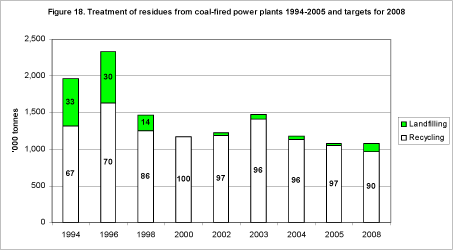
Source: same as Tables 1 and 2. Note that arisings in 2008 have been set to correspond to arisings in 2005. The figures are not projections of developments in waste arisings.

Source: same as Tables 1 and 2. Note that arisings in 2008 have been set to correspond to arisings in 2005. The figures are not projections of developments in waste arisings.
The recovery of residues in 2005 is stated in more detail in Table 33. More than 90 per cent of residues is used as raw materials in industrial manufacture of, for example, cement, concrete and plasterboard, whereas the remaining part is primarily used as backfilling, either in accordance with the provisions of Statutory Order no. 655 of 27 June 2001 from the Ministry of the Environment, or as backfilling with special approval under the Danish Environmental Protection Act.
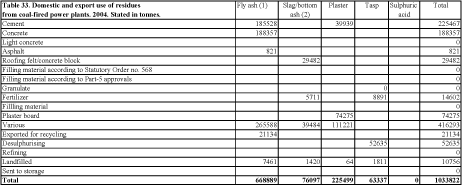
Source: Reports from Elsam and Energi E2.
5.6 Sludge from municipal wastewater treatment plants
The statement for 2005 from municipal wastewater treatment plants of amounts of sludge applied to farmland and incineration of sludge at sludge incineration plants is not yet available due to a reorganisation of the electronic reporting system.[20] For recycling and incineration, 2002 figures from the Danish EPA's sludge statistics have been used. [21]
As mentioned in Chapter 1, it was decided to state amounts of sludge for mineralisation with a dry matter content of 20 per cent, so that sludge for mineralisation would be stated with the same dry matter content as other sludge. In the treatment in sludge mineralisation plants (long-term storage) sludge is reported with around 0.5 - 1 per cent dry matter content, whereas alternatives typically contain 20 per cent.
Treatment of sludge from municipal wastewater treatment plants is shown in Figure 17. According to the Figure, 56 per cent of sludge is recycled, 43 per cent is incinerated, and 2 per cent is landfilled.
The figures for recycling include 45,600 tonnes of sludge with a dry matter content of 20 per cent, corresponding to 607,922 tonnes sludge in wet weight, which are being treated in long-term storage with the objective of further mineralisation. This amount has been included in the amounts for recycling because the sludge will be recycled after a number of years in storage.
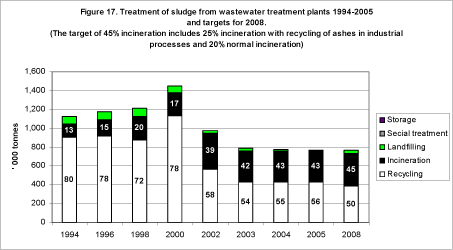
Source: same as Tables 1 and 2. Note that arisings in 2008 have been set to correspond to arisings in 2005. The figures are not projections of developments in waste arisings. The figure shown for 2005 is based on 2002 figures. The method of calculation of sludge for mineralisation has been changed with effect from 2001. The figures for recycling include 45,600 tonnes of sludge with a dry matter content of 20 per cent, corresponding to 607,922 tonnes when stated in wet weight. Long-term storage and incineration amounts include 221,730 tonnes for other uses (Carbogrit and production of concrete).

Source: same as Tables 1 and 2. Note that arisings in 2008 have been set to correspond to arisings in 2005. The figures are not projections of developments in waste arisings. The figures for recycling 2003 to 2005 are 2002 figures.
Sewage sludge is mainly recovered as fertiliser on farmland. In recent years, the requirements regarding contents of certain organic and chemical substances in sludge applied to farmland have been made stricter. In the short term, the rate of recycling is therefore expected to decrease. In the long term, it is expected the general phase-out policy for xenobiotic substances will improve the quality of sludge further.
Finally, it appears that alternative methods of sludge recovery are being discovered to an ever greater extent. After sludge incineration, the inorganic residue is recovered in the production of e.g. sand blasting agents, or cement. Sludge recovered by such alternative methods in 2002 amounted to around 220,000 tonnes[22]. In Figure 17, this amount has been included in incineration because it is recovery, not recycling.
5.7 Residues from waste incineration plants
Figure 18 shows amounts of residues (slag, fly ash, and flue-gas cleaning products) from waste incineration plants 1994 to 2005 in tonnes, including treatment option.
Residues from waste incineration plants have not been included in calculations of total waste generation, since the waste would then be counted twice in the statistics. However, residues are a large waste fraction and to secure adequate capacity for their treatment, a calculation of amounts is required.
By far the major part of residues is recycled. The recycling rate was 99 per cent in 2005, which is 1 percentage point up from 2004. Residues, however, are not recyclable when containing large quantities of heavy metals, which may leach into the soil, groundwater and surface water. In such cases landfilling is required.
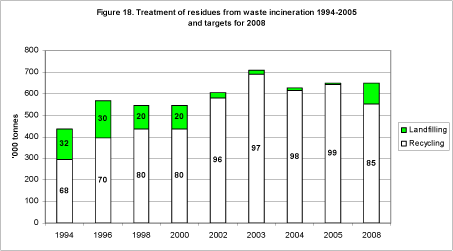
Source: same as Tables 1 and 2. Note that arisings in 2008 have been set to correspond to arisings in 2005. The figures are not projections of developments in waste arisings.
Note that Figure 18 is not comparable with Table 33 and Figure 19, because Figure 18 is exclusive of exported residues.

Source: same as Tables 1 and 2. Note that arisings in 2008 have been set to correspond to arisings in 2005. The figures are not projections of developments in waste arisings.
Contaminated fractions such as PVC, impregnated wood, and electric and electronic products, are not to be incinerated. This means that contents of heavy metals in slag will be reduced significantly. However, requirements for recycling of slag were tightened in 2000 to take account of the groundwater. The 2008 target of 85 per cent recycling has already been met.
Table 36 shows the treatment of residues from waste incineration. Naturally, amounts of residues depend on the amount of waste incinerated. Slag and flue-gas cleaning products typically comprise around 20 per cent and 5 per cent, respectively, of the waste amount led to incineration.

Source: Calculations are based on ISAG reports and registrations under the EU regulation on shipments of waste. Note that Table 36 and Figure 18 are not comparable. This is because Figure 18 does not include exports.
Table 36 shows that residues from waste incineration amounted to around 678,000 tonnes in 2005. This is 27,000 tonnes more than in 2004. Out of the 678,000 tonnes of residues removed from waste incineration plants, around 198,000 tonnes were landfilled, while around 588,000 tonnes were recycled. This means that, in reality, the stored amounts of fly ash and flue-gas cleaning products have been reduced by about 108,000 tonnes.
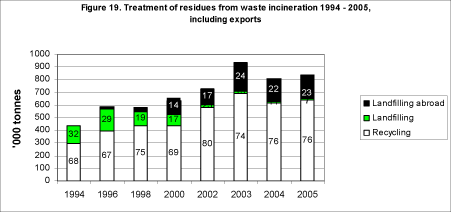
Source: ISAG reports and registrations under the EU regulation on shipments of waste.
As is evident in Figure 19, the amount of residues exported for landfilling abroad has been increasing since 1996. The amount of residues exported for landfilling went up from 21,000 tonnes in 1996 to 191,000 tonnes in 2005. Relative to 2004, there has been an increase of 10,000 tonnes in landfilled volumes. The main part of these was excavated from landfills in Denmark, as can be seen from Table 36.
From 1996 to 2005, amounts of landfilled residues have gone up by about 3 per cent and recycling has increased by 54 per cent.
[14] Exemption clause in Section 37(3), Danish Statutory Order on Waste (Statutory Order No. 619 of 27 June 2000.
[15] The service sector covers the commercial source: institutions, trade and offices.
[16] Exemption clause in Section 37(3), Danish Statutory Order on Waste (Statutory Order No. 619 of 27 June 2000.
[17] Circular No. 94 of 21 June 1995.
[18] The latest Energy Statistics are found on www.ens.dk, the Danish Energy Authority's website.
[19] Danish Energy Authority Monthly Electricity Statistics. Available at www.ens.dk.
[20] According to the EU Directive on sludge, sludge has to be reported only every third year. Denmark will therefore be requesting data on sewage sludge from the municipalities only every third year.
[21] See "Sewage sludge from municipal and private wastewater treatment plants in 2002".Environmental Review No. 5, 2004, Danish EPA. Landfilling figures are from ISAG, figures for 2004. The statement for 2005 is not yet available.
[22] The statement for 2004 is not yet available. The figure "Other, etc." is from Annex 4.4 of the sludge statistics ("Sewage sludge from municipal and private wastewater treatment plants in 2002").
Version 1.0 September 2007, © Danish Environmental Protection Agency